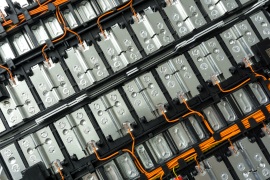With the massive increase in sales of electric cars, scalable fully automated testing of battery cell contacts is becoming increasingly important. The cells are usually connected by laser or ultrasonic welding. If a welded contact is not made properly in the process, the entire battery can fail. But how do you check a number of several hundred welding points reliably and quickly? Laser thermography enables such an inspection in a non-contact, non-destructive, reliable way – and in less than a second.

The application:
Many batteries in the automotive sector consist of several hundred round cells, where every contact must be reliably made. Electrical testing alone is not sufficient to guarantee the desired reliability. Thermographic testing is able to determine the connection cross-section. If the parameters are below the prescribed area, or in extreme cases, if there is a completely missing connection between the cell and the contacting (so-called “false friends”), the faulty battery is sorted out or reworked.
The challenge:
The challenges lie in the accessibility of the joining connection, the high thermal conductivity of the joining partners and the short cycle time available. As a rule, there is only one-sided access here, so that the contacts cannot simply be tested in transmission. In addition, the plastic carrier system must not be heated too much by the scattered radiation. The surface conditions are also challenging; there are a large number of irregular reflections, and weld spatter in particular can light up strongly in the inspection process. This requires high power excitation and sophisticated image processing to reduce the influence of these effects. And all this in a cycle time of less than half a second.
The solution: robotics
In order to be able to test quickly and robustly at the same time, it was important to be able to position the probe quickly and very reproducibly. In thermographic testing, it is not the absolute heating that is considered, but its temporal behavior, i.e. how the heat propagates in the time domain. The inspection requires a high laser intensity and a sensitive, sufficiently fast IR camera. Due to the high flexibility of the robotics, different cells and weld contact geometries can also be covered with one inspection head.
The project planning:
The customer sends edevis various “in order” and “not in order” sample parts at the beginning of the cooperation. edevis provides the customer with a feasibility study with documentation in connection with a corresponding quotation. The thermographic testing technology and the testing software is provided by edevis, the robot cell is developed with an OEM. Robot cells can be developed for prototype development in the laboratory, in-line or in-line testing.
